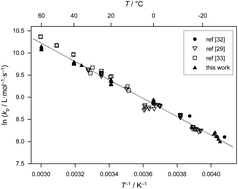Critically evaluated rate coefficients in radical polymerization – 7. Secondary-radical propagation rate coefficients for methyl acrylate in the bulk†
Abstract
Propagation rate coefficient (kp) data for

* Corresponding authors
a
Preparative Macromolecular Chemistry, Institut für Technische Chemie und Polymerchemie, Karlsruhe Institute of Technology (KIT), Engesserstraße 18, 76131 Karlsruhe, Germany
E-mail:
christopher.barner-kowollik@kit.edu
b Institut für Biologische Grenzflächen, Karlsruhe Institute of Technology (KIT), Hermann-von-Helmholtz Platz 1, 76344 Eggenstein-Leopoldshafen, Germany
c Institute of Technical Chemistry, Clausthal University of Technology, Arnold-Sommerfeld-Straße 4, 38678 Clausthal-Zellerfeld, Germany
d Technical and Macromolecular Chemistry Group, Institut für Physikalische Chemie, University of Göttingen, Tammannstraße 6, D-37077 Göttingen, Germany
e University of Western Sydney, Australian Centre for Research on Separation Science (ACROSS), School of Science and Health, Parramatta Campus, Locked Bag 1797, Penrith 2751, Australia
f Université de Lyon, Univ. Lyon 1, CPE Lyon, CNRS UMR 5265, Laboratoire de Chimie Catalyse Polymères et Procédés (C2P2), Equipe LCPP Bat 308F, 43 Bd du 11 Novembre 1918, F-69616 Villeurbanne, France
g ARC Centre of Excellence for Free-Radical Chemistry and Biotechnology, Research School of Chemistry, Australian National University, Canberra ACT 0200, Australia
h Department of Chemical Engineering, Dupuis Hall, Queen's University, Kingston, Ontario K7L 3N6, Canada
i
Polymer Reaction Design Group, Institute for Materials Research, Universiteit Hasselt, Agoralaan D, BE-3590 Diepenbeek, Belgium
E-mail:
tanja.junkers@uhasselt.be
j Department for Biomaterials Research, Polymer Institute of the Slovak Academy of Sciences, Dubravska cesta 9, 845 41 Bratislava, Slovakia
k Department of Chemistry, University of Canterbury, Private Bag 4800, Christchurch 8140, New Zealand
l Institute of Chemical and Engineering Sciences, 1 Pesek Road, Jurong Island, Singapore 627833
m Eindhoven University of Technology, Polymer Reaction Engineering, PO Box 513, 5600 MB Eindhoven, The Netherlands
Propagation rate coefficient (kp) data for

 Please wait while we load your content...
Something went wrong. Try again?
Please wait while we load your content...
Something went wrong. Try again?
C. Barner-Kowollik, S. Beuermann, M. Buback, P. Castignolles, B. Charleux, M. L. Coote, R. A. Hutchinson, T. Junkers, I. Lacík, G. T. Russell, M. Stach and A. M. van Herk, Polym. Chem., 2014, 5, 204 DOI: 10.1039/C3PY00774J
This article is licensed under a Creative Commons Attribution 3.0 Unported Licence. You can use material from this article in other publications without requesting further permissions from the RSC, provided that the correct acknowledgement is given.
Read more about how to correctly acknowledge RSC content.
 Fetching data from CrossRef.
Fetching data from CrossRef.
This may take some time to load.
Loading related content
